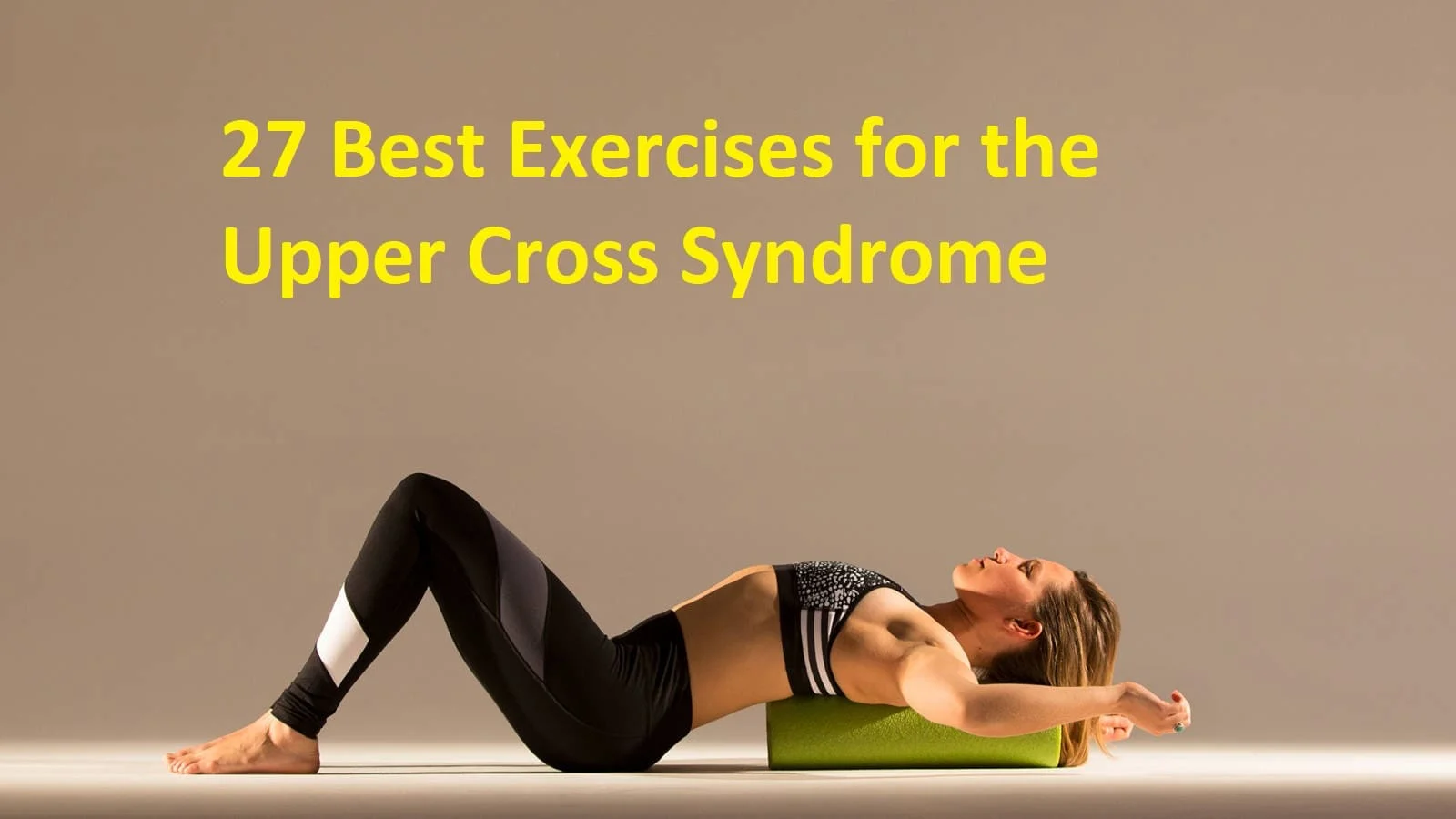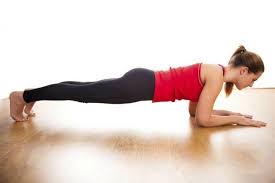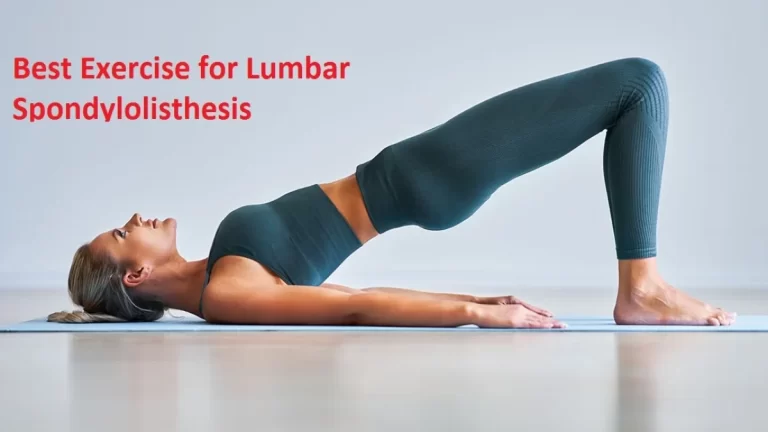27 Best Exercises for the Upper Cross Syndrome
Exercise plays a crucial role in managing and correcting Upper Cross Syndrome (UCS). Upper Cross Syndrome (UCS) is a postural condition characterized by muscle imbalances in the upper body. It typically results from prolonged periods of poor posture, such as hunching over a computer or slouching. UCS can lead to discomfort, pain, and reduced mobility in the neck, shoulders, and upper back.
These exercises target specific muscle groups to strengthen weakened muscles and stretch tight ones, ultimately improving your posture and reducing discomfort.
What is an Upper Cross Syndrome?
The term “Upper Cross Syndrome” refers to a muscle imbalance between the cervical spine’s anterior and posterior chains and the middle-to-upper thoracic spine.
Upper crossed syndrome (UCS) is characterized by the deformation of the neck, shoulder, and chest muscles, which typically results from bad posture. The majority of UCS instances are brought on by persistent bad posture. specifically, protruding the head forward while standing or sitting for extended durations.
Strengthening, stretching, and dietary adjustments can all be used to treat Upper Cross Syndrome. By addressing the developed muscle weakness, strengthening exercises can promote good alignment and posture.
Exercises that stretch the muscles can release tension, thereby balancing out the stress in the tight and weak muscles. For addressing the underlying cause of the disease, lifestyle adjustments such as breaking up or minimizing repeated actions and maintaining proper posture are also essential.
What are the symptoms?
- Neck pain
- Headache
- Weakness in the front of the neck
- Restricted movement in the neck and shoulders
- Pain and reduced movement in the ribs
- Strain in the back of the neck
- Upper arm discomfort, the sensation of tingling and numbness
- Pain in the upper back and shoulders
- Tightness and pain in the chest
- Lower back pain
Exercise advantages for upper cross syndrome include the following:
The following advantages can be achieved if you regularly exercise:
- Improves daily activity performance
- Bolster your posture or relax your muscles
- Minimise pain
- Enhance movement
- Increased adaptability
- Helps build up weak muscles.
- Reduce stiffness or tension.
- You might be able to regain mobility with exercise.
- Boosting cooperation.
Recommended exercise for the upper cross syndrome:
The exercises listed below are the greatest and most beneficial for you.
Lying down exercises
- Lay flat on the ground with a thick pillow positioned so that it is aligned with your spine and about a third of the way up your back.
- Allow your knees to naturally fall wide and your arms and shoulders to roll out.
- The position of your head should be neutral and unstrained.
- When it does, use a pillow for assistance yourself
- For five to ten minutes, maintain this position.
- Then unwind.
- After that, take a neutral attitude again.
- Repeat this exercise 5-10 times per day.
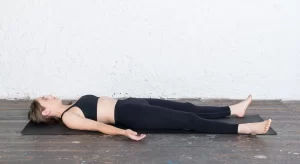
Floor cobra
- Lean on the floor with your palms facing the ground and your arms by your sides or in front of you in the “Superman” position.
- Now Pinch the shoulder blades together and lift the chest off the floor.
- Hold for a few seconds.
- Then take a position that a neutral.
- Then unwind.
- Return the body to the ground gradually while maintaining a tucked-in chin.
- Repeat this exercise 5-10 times per day.
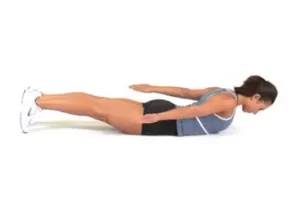
Self massage sternocleidomastoid (SCM)
- Grab the middle of your left SCM muscle with your right thumb and forefinger until you feel a sensitive or sore area in the muscle belly.
- Keep your grip there for 15 seconds.
- Release this region, then raise your thumb and forefinger by one fingerbreadth.
- As you progress along the muscle, keep holding each location until you reach the top of the muscle.
- Then adopt an impartial stance.
- Then relax
- On the right SCM, repeat.
- Repeat this exercise 5-10 times per day.
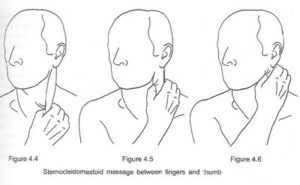
Quadruped Thoracic Rotation Stretch
- Kneel on both knees.
- For support, place one hand on the floor and the other on the back of your head.
- Twist your body towards the direction of the extended arm, and try to touch the elbow of the arm on your head to the extended arm.
- Now turn your body in the opposite direction and look up as your elbow rises (this will open up your upper back).
- Then adopt an impartial stance.
- Then relax.
- Repeat this exercise 5-10 times per day.
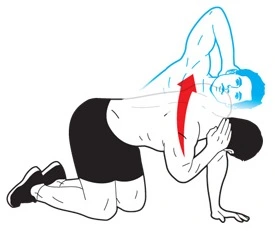
Warrior 1 Pose (Virabhadrasana I)
- To begin, stand up and advance with your right foot three to four feet apart from your left foot.
- To align your right knee with your right ankle and your right thigh with the floor, bend your right knee to a 90-degree angle.
- While maintaining a straight left leg, turn your left foot out slightly.
- Take a deep breath in while pushing your shoulder blades together, lifting both arms straight up towards the ceiling, and tucking your chin towards your chest.
- Release the stance by taking a breath, then stand up normally afterward.
- Then adopt an impartial stance.
- Then relax.
- Switching foot and repeat exercise.
- Repeat this exercise 5-10 times per day
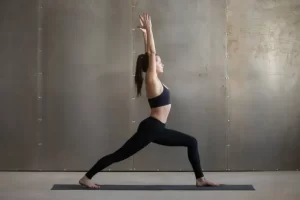
One Arm Stretch
- Start by standing comfortably 5-6 inches from a wall with your back to it.
- Put your hand palm down, elevate the arm on the damaged side, and try to touch the wall with the thumb side of your hand.
- Keep your arm straight at all times.
- Once you feel a stretch in your muscles, shift your body away from your raised arm.
- Maintain this stretch for 30 seconds.
- Then take a position that is neutral.
- Then unwind.
- Repeat on the other side
- Repeat this exercise 5-10 times per day.

Levator Scapula Stretch
- Begin with a seating position on the chair or table.
- Maintain a straight back and shoulders.
- Raise the arm to 90 degrees with the elbows bent.
- Look at the area under the arms.
- Continue stretching for a brief while.
- After that, revert to your neutral position.
- Then unwind.
- Repeat on the opposite side
- Repeat this exercise 5-10 times per day.
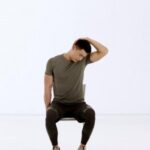
Chin Tucks
- To begin, maintain a straight posture while sitting or standing and fix your gaze across the room.
- To help you focus your actions, place your index finger on your chin.
- Tuck your chin into your neck and slowly tilt your head back until it is entirely horizontal.
- The movement should result in a double chin while keeping a straight line of vision, as opposed to lowering your head to look at your toes.
- Return to your neutral position after that.
- Then unwind.
- Repeat this exercise 5-10 times per day.

Prone Ys
- Exercises may be performed while lying on your stomach on a big exercise ball with your arms hanging straight down or off the side of a bed.
- Make a Y-shape with your arms and body by raising them to a 45-degree angle (while keeping your thumbs up).
- Only extend your arms to shoulder level.
- Now return the arms to their initial position.
- After that, revert to your neutral position.
- Then relax.
- Repeat this exercise 5-10 times per day.
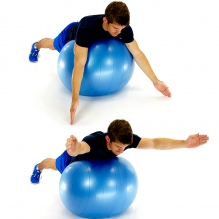
Cat-Cow Pose
- Place your hands and knees on the ground in the tabletop position to begin.
- Maintain a straight back.
- Maintain your hands and feet firmly planted on the ground.
- Then take a breath, look up, and let the air fill your belly.
- For a brief while, maintain this posture.
- Then, as you exhale, tuck your chin into your chest and raise your spine to the ceiling.
- Your lower back is being gently stretched as you say this.
- For a brief while, maintain this posture.
- Then take a position that is neutral.
- Then unwind.
- Repeat this exercise 5-10 times per day.
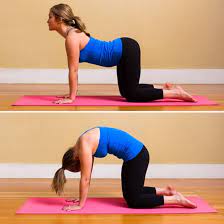
Child’s Pose
- Begin by relaxing into a kneeling position.
- keeping your knees and hips in alignment.
- Inhale deeply, then bend forward to lower yourself.
- Bring your brow to the ground.
- You will extend your arms straight out in the direction towards you.
- For a brief while, maintain this posture.
- Exhale your breath.
- Then progressively take a viewpoint that is neutral.
- Then unwind.
- Repeat this exercise 5-10 times per day.

Cobra Pose
- Lay flat on your stomach to begin.
- your shoulders with your hands there.
- Put your elbows close to your ribcage.
- Now breathe in and place your palms on the ground.
- Then, raise your chest off the floor.
- Retain a neutral neck position.
- Then take a position that is neutral.
- Then unwind.
- Repeat this exercise 5-10 times per day.
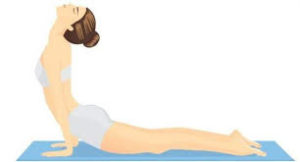
Supine Spinal Twist
- Beginning by lying on your back.
- Bend both of your knees.
- Maintain a flat foot position.
- Draw a deep breath.
- Steadily place your shoulders on the floor.
- To one side, bend both knees.
- Shift your gaze to the opposing side.
- Hold it there for a short while.
- Then progressively take a viewpoint that is neutral.
- Then unwind.
- Switch sides gradually.
- Repeat this exercise 5-10 times per day.
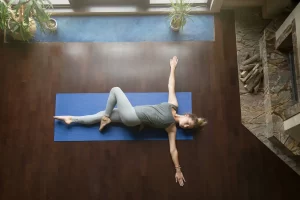
Wall Angels
- Start by standing with your arms up in the air.
- I am maintaining a sideways elbow position.
- Next, gradually lower your arms.
- Put your elbows as far back as you can.
- The shoulder blades together after that.
- Sustain this position for a few moments.
- Then slowly take a step back into a neutral position.
- Then unwind.
- Repeat this exercise 5-10 times per day.
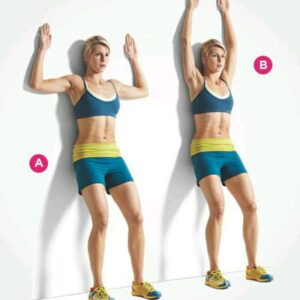
Seated shoulder Stretch
- As you sit down, cross your legs.
- Put your palms down and your fingers about a foot away from your hips.
- Try around with how it feels to lift your palms off the ground and extend your fingers.
- Lean backward towards the ground while maintaining straight arms.
- You must completely straighten your arms to get the most out of the stretch.
- If arm bending is unavoidable, move the hands farther away from the hips to widen the stretch
- Return to the Neutral position following that.
- Now unwind.
- Repeat this exercise 5-10 times per day.
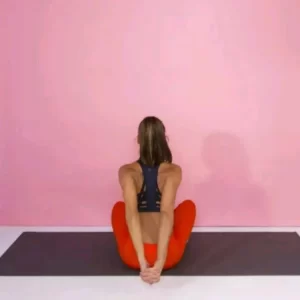
Reverse shoulder stretch
- Start by taking a good position.
- Slowly stretch your arms behind your body while locking your elbows behind you.
- Your intermuscular muscles should feel tense between your shoulder blades.
- Avoid venturing outside of your comfort zone.
- In contrast to arm or neck pain, minor muscular pains or burning are acceptable.
- Avoid shrugging your shoulders away from your ears
- Return to the Neutral position following that.
- Now unwind.
- Repeat this exercise 5-10 times per day.
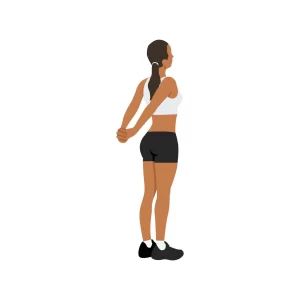
Supine Chin Tuck
- Tuck your chin in when lying on your back, but avoid looking at your chest.
- From this position, slowly lift your head 3 to 4 inches off the ground or your bed (or whatever surface you’re sitting on).
- After about five seconds, she remained in this position.
- Go back to being in a neutral stance.
- Then unwind.
- Repeat this exercise 5-10 times per day.
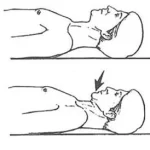
Door Way Shoulder Stretch
- Stand in a doorway that is open.
- With the palms facing the front and the elbows bent at a 90-degree angle, each arm should be elevated to the side.
- Your palms should be on the door frame.
- If this hurts too much, try lowering your elbows a little.
- Move one foot slowly forward.
- The muscles in your shoulders and chest should feel stretched.
- Maintain a straight posture while standing.
- Hold for a short while.
- Then take a position that is neutral.
- Then unwind.
- Repeat this exercise 5-10 times per day.
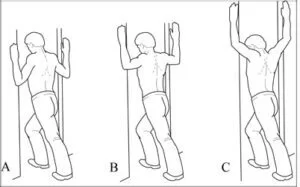
Plank
- Start by taking a comfortable floor position.
- Directly beneath your shoulders, position your forearms.
- Then, carefully raise your torso off the ground by putting pressure on your knees and forearms.
- To find a comfortable position, raise your torso.
- Now lift your knees and tuck your toes beneath.
- Your body consequently forms a straight line.
- Continue this position for a few moments.
- Then progressively take a viewpoint that is neutral.
- Then unwind.
- Repeat this exercise 5-10 times per day.
Resistance band pulls
- Start off by standing comfortably.
- Hold a small resistance band over your hand.
- Maintain a 90-degree angle with your elbows.
- Your wrists should be spread wide into the band.
- Maintain this position for a few moments.
- Then slowly take a step back into a neutral position.
- Then unwind
- Repeat this exercise 5-10 times per day.
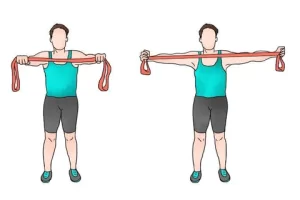
Shoulder Blade Retraction
- Beginning by establishing a relaxed stance on the surface of the ground.
- Keep your head and neck relaxed.
- Now squeeze your shoulder blades.
- Hold it for a few seconds.
- Then slowly return to your neutral position.
- Then relax.
- Repeat this exercise 5-10 times per day.
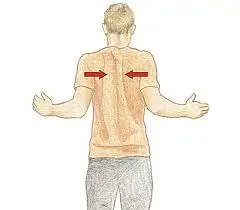
Upper Trapezius Stretch
- Sit upright in a chair with your shoulders in line with your ears and your head and neck in a neutral position.
- Your right hand should be used to hold the edge of your chair.
- Bring your chin in a little.
- Look straight ahead while cocking your head to the left.
- Putting your left hand on your head’s right side.
- Shift your head to the left slightly.
- Hold for a short while.
- To lengthen the stretch, apply light pressure.
- Keep your head from craning into place.
- Bring your neck and head back to their natural state.
- Then relax.
- Reverse sides and continue.
- Repeat this exercise 5-10 times per day.

Foam roller for neck
- Start with pot your neck on the foam roller, at the top where it connects to your head.
- Hold where you feel a stiffness as you slowly tilt your head to the right.
- As you breathe out, tilt your head to the left.
- Repeat for a few seconds.
- Then slowly return to your neutral position.
- Then relax.
- Repeat this exercise 5-10 times per day.
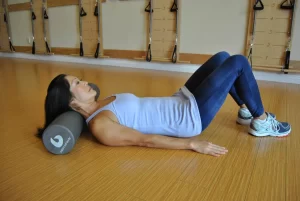
Back Rows with hand
- Sit down on the floor and extend your legs straight out in front of you to start.
- Place the band’s center around the feet while holding the grips.
- Then construct a loop on each foot by wrapping each end inside and around each foot one more time.
- Holding the handles in front of you with your elbows bent next to your side, sit tall with your abs taut.
- Pull the handles back until your elbows are behind you and they are near to your side.
- Release gradually.
- Then take a position that is neutral.
- Then unwind.
- Repeat this exercise 5-10 times per day.
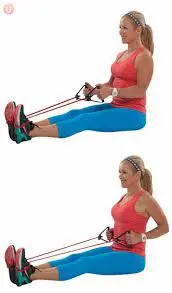
Reverse fly
- Start with a standing position on the ground.
- Step onto the band’s center.
- Keep your spine long and neutral while you lean slightly forward, hinge at your hips, and keep your knees slightly bent Throughout the action.
- When your hands are at chest height or higher, raise the band up and out to the sides.
- Converge the shoulder blades.
- For a brief while, maintain this posture.
- Return to the starting position gradually.
- Then unwind.
- Repeat this exercise 5-10 times per day.
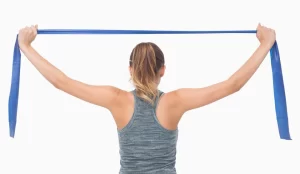
Isometric Neck Strengthening:
- It can be made to resemble the Range of Motion Neck Stretch by adding resistance.
- While seated, place the heel of one hand on your forehead.
- As you softly press your forehead against it, let your hand gently resist you.
- Attempt not to force the hand back with your head.
- Hold the position for a few seconds.
- Repeat the exercise with your hand on the left side of your head, pushing against resistance as you travel in that direction, then The right side, and finally the back of your head, to lengthen and strengthen your neck on all sides.
- After that, revert to the Neutral posture.
- Now unwind.
- Repeat this exercise 5-10 times per day.
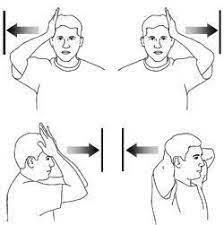
Bear Hugs
- Begin by assuming a relaxed position on the surface of the ground.
- Holding onto a theraband, wrap it around your shoulder blades in the middle.
- At this point, extend your arms straight out to the side at a 90-degree angle.
- Maintaining the straightest arm you can.
- Next, pull the band inside and forward as you are hugging someone.
- Hold the position where your hands come together for a few seconds.
- Then going back to the beginning position.
- Then slowly take a step back into a neutral position.
- Then unwind.
- Repeat this exercise 5-10 times per day.
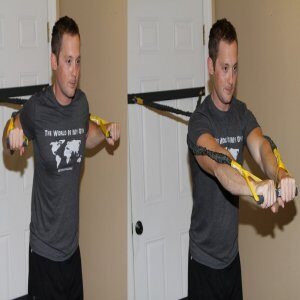
What safety measures are necessary when exercising?
- Stretch and warm up before exercising.
- Maintain a straight spine while working out.
- Prevent strenuous exercise
- Stop exercising if you experience sudden discomfort.
- Between exercises, rest.
- Remain hydrated.
Before beginning any exercise program, it’s essential to consult with a healthcare professional or physical therapist to ensure these exercises are suitable for your condition and to receive personalized guidance.
When do you stop working out?
- Severe muscular ache
- You’re contagious.
- If there is any discomfort or numbness.
- Headache and Fever
- Exercise should be stopped if it hurts.
Prevention of upper cross syndrome:
- By taking breaks every 10-15 minutes when seated or working on challenging tasks, you can reduce the amount of time you spend reading, driving, watching TV, or using laptops and computers
- Receiving sufficient aerobic exercise, ideally 30 to 35 minutes per day from low-impact sports like walking or swimming, cycling, too.
- Recognizing and avoiding actions, motions, or activities that exacerbate and heighten symptoms for as long as possible The ache persists while relaxing.
- Exercising to target weakening muscles in the upper front neck and lower shoulders, doing stretches to target tight muscles in the back neck, shoulders, and chest, and continuing and repeating a couple of times daily.
FAQs
An upper cross syndrome is what?
Upper Back Pain occurs when the muscles in your shoulders, neck, and chest are out of balance, with some being too weak and others too tight.
The Cross Syndrome These muscles appear to clump together in the shape of an X when the body is
viewed from the side, giving the disorder its name.
Upper cross syndrome: is it treatable?
The upper crossing syndrome, as it is also known, develops when the muscles in the neck, upper back, chest, and shoulders are not balanced. It is typically caused by bad posture or inappropriate repetitive movements, and it can be corrected with the right, regular exercise.
What kind of therapy is most effective for upper cross syndrome?
The most successful therapies for UCS are typically those that focus on mobility, flexibility, and spinal modifications. Many of the problems associated with upper cross syndrome can be resolved by combining routine stretching, strengthening of the weak muscles, corrective posture management, and modifications.
Which is affected by upper crossed syndrome?
Athletes, students, desk workers, and anyone else who spends a lot of time with poor posture is prone to upper crossed syndrome. The upper cross syndrome can happen to anyone.
What workouts are beneficial for upper-crossed syndrome?
One Arm Chest Stretch
Upper Trapezius Stretch
Cobra Pose
Standing to Pull Apart
Bear Hugs
Plank
How often should someone with upper cross syndrome exercise?
The exercises for the upper cross syndrome can be done daily for a minimum of 30-40 minutes.
A daily program of light stretching and exercise will be beneficial to you.
Can you improve upper cross syndrome with exercise?
Exercise is frequently used to alleviate pain and avoid additional discomfort and injury.
Exercises that strengthen the body’s supporting muscles include stretches.
Regular exercise can assist in reducing the frequency of recurrent discomfort.
Which factors lead to the upper cross syndrome?
Although there are several actions that might induce upper crossing syndrome, the majority of instances are brought on by poor posture, particularly prolonged sitting or standing with the head forward. The use of a computer or laptop is one activity that encourages this posture. driving.
References
- Young, B. (2018, September 18). Upper Crossed Syndrome. Healthline. https://www.healthline.com/health/upper-crossed-syndrome
- Turetsky, L. (2023, July 4). Upper Crossed Syndrome Exercises, Causes, Symptoms. Back Intelligence. https://backintelligence.com/upper-crossed-syndrome-exercises/
- Evergreen, B. (2021, December 20). How to Fix Your Posture: Upper Cross Syndrome. Evergreen Rehab and Wellness Coquitlam, Surrey, and Langley. https://evergreenclinic.ca/how-to-fix-your-posture-upper-cross-syndrome/
- Passalacqua, B. (2023, September 21). Yoga for Upper Cross Syndrome: 7 Poses for Fixing the Slouch in Your Neck. Breathing Deeply. https://breathingdeeply.com/yoga-therapy-for-that-darn-neck/

